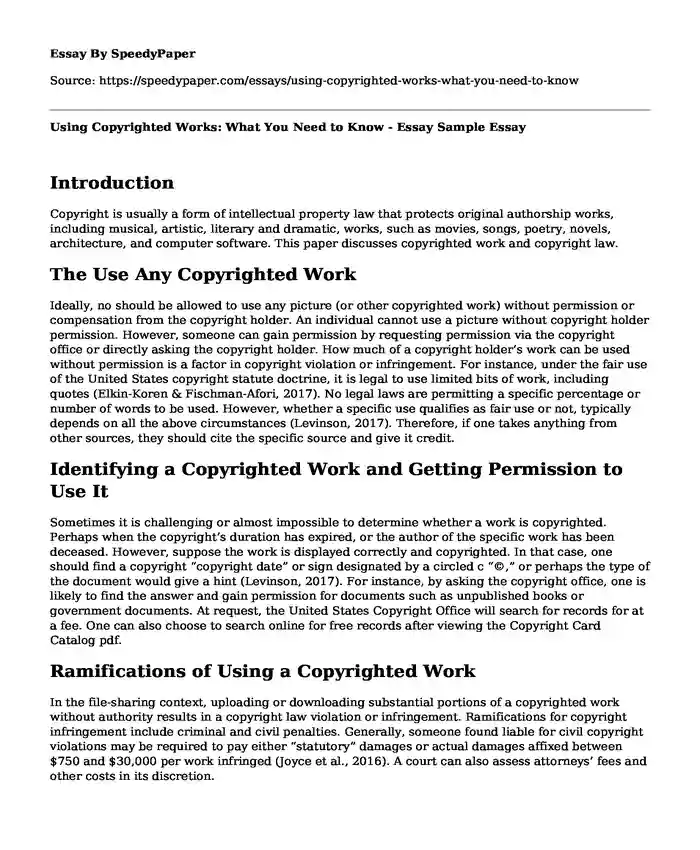
| Type of paper: | Essay |
| Categories: | Law |
| Pages: | 3 |
| Wordcount: | 739 words |
Introduction
Copyright is usually a form of intellectual property law that protects original authorship works, including musical, artistic, literary and dramatic, works, such as movies, songs, poetry, novels, architecture, and computer software. This paper discusses copyrighted work and copyright law.
The Use Any Copyrighted Work
Ideally, no should be allowed to use any picture (or other copyrighted work) without permission or compensation from the copyright holder. An individual cannot use a picture without copyright holder permission. However, someone can gain permission by requesting permission via the copyright office or directly asking the copyright holder. How much of a copyright holder’s work can be used without permission is a factor in copyright violation or infringement. For instance, under the fair use of the United States copyright statute doctrine, it is legal to use limited bits of work, including quotes (Elkin-Koren & Fischman-Afori, 2017). No legal laws are permitting a specific percentage or number of words to be used. However, whether a specific use qualifies as fair use or not, typically depends on all the above circumstances (Levinson, 2017). Therefore, if one takes anything from other sources, they should cite the specific source and give it credit.
Identifying a Copyrighted Work and Getting Permission to Use It
Sometimes it is challenging or almost impossible to determine whether a work is copyrighted. Perhaps when the copyright’s duration has expired, or the author of the specific work has been deceased. However, suppose the work is displayed correctly and copyrighted. In that case, one should find a copyright “copyright date” or sign designated by a circled c “©,” or perhaps the type of the document would give a hint (Levinson, 2017). For instance, by asking the copyright office, one is likely to find the answer and gain permission for documents such as unpublished books or government documents. At request, the United States Copyright Office will search for records for at a fee. One can also choose to search online for free records after viewing the Copyright Card Catalog pdf.
Ramifications of Using a Copyrighted Work
In the file-sharing context, uploading or downloading substantial portions of a copyrighted work without authority results in a copyright law violation or infringement. Ramifications for copyright infringement include criminal and civil penalties. Generally, someone found liable for civil copyright violations may be required to pay either “statutory” damages or actual damages affixed between $750 and $30,000 per work infringed (Joyce et al., 2016). A court can also assess attorneys’ fees and other costs in its discretion.
Protect Your Work, So It Is Protected
Copyright protection is usually automatic under international law; however, if your (author’s) work is infringed, the court may request evidence to support the claim. To protect the work, one should:
Ensure their work is properly marked; A correctly and properly worded notice will discourage infringement, as it clearly states that the particular work is under legal protection.
One should register their work; if the work is infringed and the claim to copyright is disputed (For instance, in a case of plagiarism, where the other party may claim the original work is theirs), one may need evidence to help prove their claim. Therefore, these valuable pieces of evidence may be provided by copyright registration services; they may also provide valid proof of the work’s date and content.
Two Places or Internet Sites to Find Videos that Are Either Copyright Free or that One Has Rights to Use
Pexels
Pexels have integrated their free video collection stock to the main site, and it is exquisite. One has access to several copyright-free videos, tagged appropriately, and full HD stunningly shot.
YouTube
YouTube is considered the world’s most comprehensive video hosting site, and also a popular search engine can help one with free footage without standard copyright.
References
Elkin-Koren, N., & Fischman-Afori, O. (2017). Rulifying fair use. Ariz. L. Rev., 59, 161. https://heinonline.org/HOL/LandingPage?handle=hein.journals/arz59&div=7&id=&page=
Joyce, C., Ochoa, T. T., Carroll, M. W., Leaffer, M. A., & Jaszi, P. (2016). Copyright law (p. 542). Durham, NC: Carolina Academic Press. https://cap-press.com/books/isbn/9781632847874/Copyright-Law-Tenth-Edition
Levinson, L. (2017). Adapting Fair Use to Reflect Social Media Norms: A Joint Proposal. UCLA L. Rev., 64, 1038. https://heinonline.org/HOL/LandingPage?handle=hein.journals/uclalr64&div=28&id=&page=
Cite this page
Using Copyrighted Works: What You Need to Know - Essay Sample. (2023, Nov 15). Retrieved from https://speedypaper.com/essays/using-copyrighted-works-what-you-need-to-know
Request Removal
If you are the original author of this essay and no longer wish to have it published on the SpeedyPaper website, please click below to request its removal:
- Essay Sample on Police Suicide: The Tough Life of a Cop
- Legality Proposition, Business Law Essay Sample
- Free Essay Sample on Australian Legal System
- Law Essay Sample: Declaratory Judgment, Counterclaim, Shrink-Wrap License
- Essay Sample on Real Estate Disclosure Laws
- The Top Five Theoretical Frameworks That Best Explain the Causes of Crime. Essay Example
- Right to Strike. Free Essay
Popular categories




